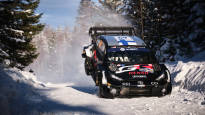Major changes will be made to the World Rally Championship in the coming years.
On Wednesday, news was expected regarding the future of the World Rally Championship, when the World Motor Sports Council, operating under the International Automobile Federation (FIA), met for the first time this year. The meeting was chaired by the president of the FIA Mohammed Ben Sulayem.
The future of the World Rally Championship has been talked about for a long time due to, among other things, the small number of competing teams.
Read more: Comment: The World Rally Championship asked the fans for help – I filled out a special survey and was amazed
Now the council gave the green light to the plans of the WRC working group. The working group had prepared an overview of the current state of the World Rally Championship and its future goals. According to the working group, a much greater focus is needed on the PR and marketing work of the World Series. In addition, it introduced changes related to technical and sporting matters.
Technical changes: Hybrid removed
The current rally1 cars will be extended to 2025 and 2026. The biggest news is that the hybrid unit will be phased out after the current season. The goal is to calculate costs. The performance lost by removing the hybrid is compensated by reducing the total weight of the car and by changing the air restrictor and aerodynamics.
In preliminary speculations, three options had been raised in practice:
1) Let’s continue with the current cars.
2) Let’s make a change to the cars, as it was finally decided to do.
3) Let’s raise rally2 cars to the main class with certain changes that increase the performance of rally2 cars.
Rally2 cars will continue in their current form, but starting in 2025, it will be possible to improve the performance of rally2 cars in the World Rally Championship within the framework of the rules. The separate package consists of, among other things, a larger restrictor, a larger exhaust pipe and a rear wing. The goal is to reduce the performance difference between rally1 and rally2 cars.
From 2026, the WRC’s main class will use rally1 cars, whose revised technical regulations will be introduced based on the current rally1 concept. These rules apply alongside the current rally1 rules for the 2026 season.
From the 2026 season onwards, the power of rally1 cars is 330 horsepower. There will be a cost cap on the power sources and the technology will be limited to match rally2 cars. Aerodynamic efficiency is limited to contain costs.
To save costs, all new cars have the same safety frame around which manufacturers build their cars.
In the future, the price per rally1 car is limited to 400,000 euros. It is a significant change, as the price of current rally1 cars has been reported to be around one million euros. From the 2026 season onwards, the teams must also commit to selling the cars after the race if necessary.
The aim is to introduce a class of electric cars to the WRC series as quickly as possible, whose technical regulations could achieve the performance of rally cars.
Competition format changes: More flexibility
Among other things, drivers of the World Championship have criticized that the competitions last too long. There have been hopes for shorter race weekends to increase public interest.
Now the FIA gave the event organizers of the World Rally Championships more freedom in developing the rally routes. Therefore, the start dates of the races and the number of EK kilometers may vary, but all rallies must end on Sunday with the Power Stage.
In the future, the calendar may include a small number of shorter sprint-style races and longer endurance-type races. However, the goal is that during the season the total kilometers will remain mostly unchanged and events will still be organized on asphalt, gravel and snow.
The cost-saving measures also include limiting the number of traveling staff and rally kilometers.
For example, the location of the service park can be changed in the middle of the World Cup rally, which increases flexibility and enables a smaller surface area required for the service park.
Now the decisions made in Geneva, Switzerland, provide guidelines for the new regulations, which are to be confirmed next summer.
